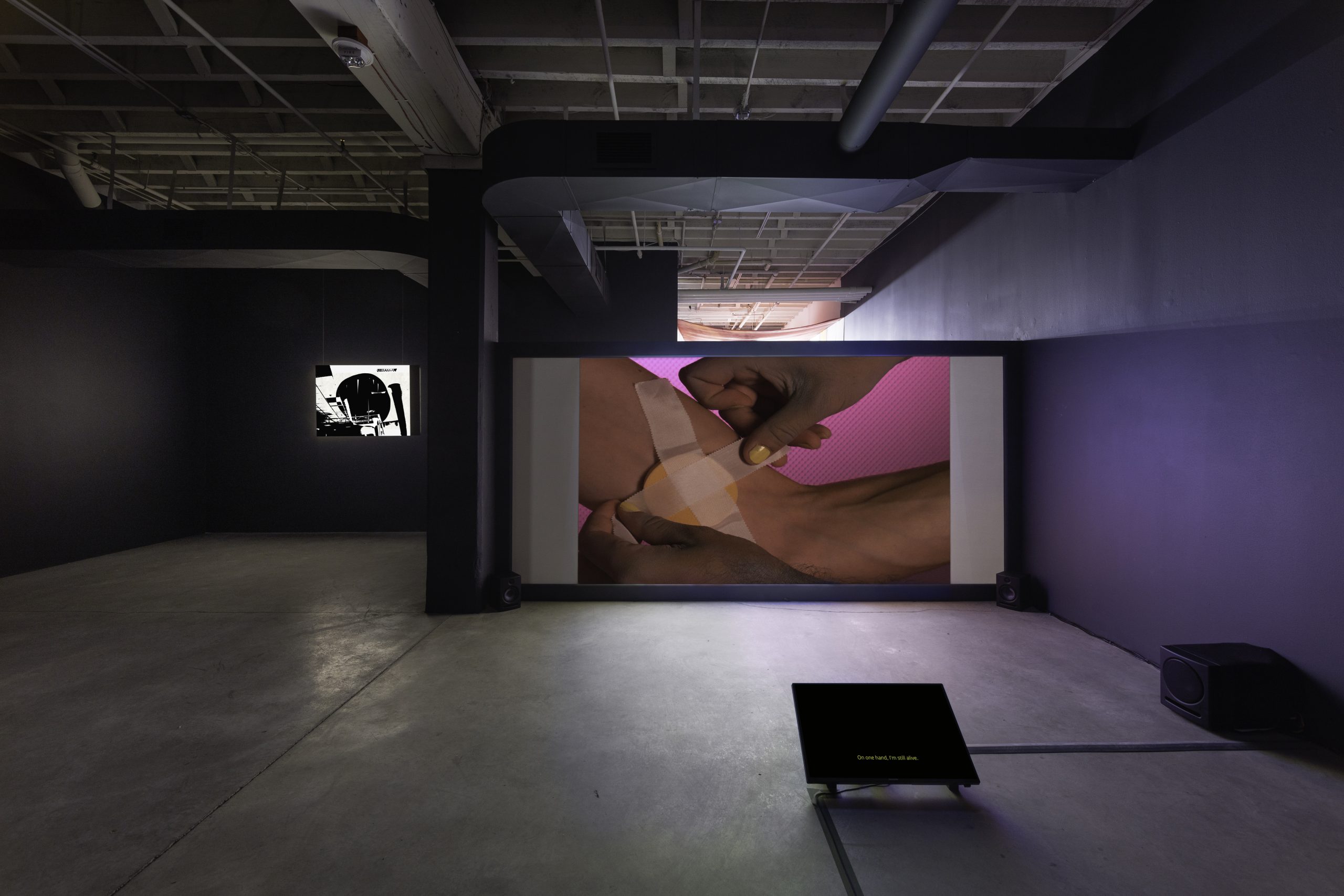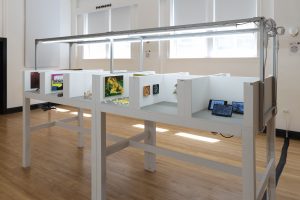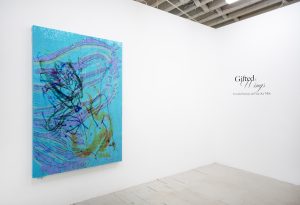In the perhaps unexpected place of Omaha, Nebraska lies Bemis Center for Contemporary Arts, a giant warehouse and sculpture/ceramics facility that hosts provocative exhibitions, live performances, multiple cohorts of artists-in-residence a year, a sound/music residency, and, not to be forgotten, a curatorial residency. A space for experimental art and a place for artists to live and work, Bemis is a hub of ideas and discussion, a site for creation in the middle of the city.
Earlier this year I spoke with the 2019-2021 curator-in-residence, Sylvie Fortin. Originally from Montréal, Canada, Fortin is an independent curator, researcher, critic, and editor whose work focuses on the notion of hospitality as well as its relationship to art. What is notable, radical, and affecting, Fortin applies hospitality to how she approaches curation, her research methodologies, and more specifically, her exhibition I don’t know you like that: The Bodywork of Hospitality, which was on view at Bemis from December 9, 2021 to March 20, 2022. During her time as curator-in-residence at Bemis, she developed three curatorial projects that engaged with the community and culture of Omaha through the lens of hospitality. In our conversation, we discuss different traditions of hospitality in relation to her own research as well as the ways in which hospitality can be defined, shaped, and enacted.
*Learn more about the groundbreaking exhibition I don’t know you like that: The Bodywork of Hospitality in Sixty’s recently published review.
![Image: Celina Eceiza, La lengua de los distraídos [The Distracted Language], 2021, site-sensitive installation: chalk on canvas, hand-dyed fabric, felt carpet, and soft sculptures, dimensions variable, courtesy of the artist. Image courtesy of Bemis Center for Contemporary Arts; photo: Colin Conces. A colorful installation piece where viewers can walk into. Pillows lay on a bright blue floor. The walls are made of (mostly) yellow and blue fabric.](https://sixtyinchesfromcenter.org/wp-content/uploads/2022/06/Gallery-3-20211210_cc_9504-1024x683.jpeg)
Christina Nafziger: What initially got you interested in hospitality as a topic within your curatorial research? How would you define the term “hospitality” in regards to the scope of your exhibition, I don’t know you like that: The Bodywork of Hospitality?
Sylvie Fortin: In 2017, after leading institutions for many years, I decided to return to an independent practice (or, rather, an interdependent practice). I had already been thinking about the question of hospitality for a while. Initially, in 2012, the term had very limited valence – in the artworld it evoked relational practices; beyond the artworld, it was generally understood as either an industry or a somewhat dated and gendered notion of etiquette. Flash forward to 2017 and “hospitality” has been wedded to “refugee crisis,” following the 2015 intense media spectacularization of the Mediterranean and Syrian mass migrations. The currency of the term shifted drastically within those five years. From the beginning, my research was premised on retooling to chart a way out of the twin failures of political and esthetic hospitality in the West/North.
In parallel, and perhaps as a consequence of this research into hospitality, I’m determined to expand the capaciousness of curatorial practice. I was, and remain, dissatisfied by the very limited range of possibilities that are afforded to (and claimed by) curators. At present, curators are institutionally affiliated, independent, and curatorial studies faculty. Institutionally affiliated curators are hemmed in by the exhibition spaces and calendars of their institutions, and by the dictates of their collections. Sadly, this means that few have any time to travel and research: research becomes reduced to attending the same art fairs, biennials, handful of other shows and reading the same periodicals. This accounts for the market-driven homogeneity of our field. Independent curators enjoy, in fact, little independence: they are too often called on to render the same services as their affiliated colleagues, at a much lower price, with no benefits. They provide their institutional hosts free research, expanded networks, and cultural capital. Through my curatorial research into hospitality, I’m trying to figure out another way of working by developing different relationships and solidarities that foreground three things: one, working very closely with artists and finding ways to acknowledge and support the full spectrum of their practice, including their invisible labor and unrealizable projects; two, developing deep connections with the communities with which I collaborate; three, redistributing resources.
Coming back to the notion of hospitality, I should stress that I’m partial to the definition of hospitality as unconditional. There are various understandings of hospitality, from Kant to Levinas to Derrida – and now Karen Barad, whose thinking has been very empowering. For me, the dynamics of unconditional hospitality means that one cannot be a host. Just as no one is a guest. One only becomes a host when a guest shows up. And one becomes a guest when a host welcomes. Hospitality is a co-production. Host and guest are neither states, nor properties or identities. Hospitality happens – it takes and makes place: it’s temporary. The etymology of hospitality is also crucial: it links hospitality and hostility. This shared etymology reminds us that without (the potential of) hostility, there’s no hospitality: the dangers and pleasures of hospitality are therefore symmetrical for host and guest. Without this, there is no hospitality. Sadly, however, hospitality is often reduced to conviviality or mutualism which, in the end, are transactional and hemmed in by accounting. Hospitality is much more than that. It’s an elaborative relationship. Duty and debt have no part in it. There should be no return in sight. Returns are possible, but they should not be already built into the relationship. The moment when duty or debt come into play, you are talking about family and property. One of the biggest theoretical challenges of the project is to free hospitality from debt and duty, which is to say, to free it from property and the “home.”
![Image: View of the exhibition I don’t know you like that: The Bodywork of Hospitality at Bemis Center for Contemporary Arts, 2021. Front to back: Celina Eceiza, La lengua de los distraídos [The Distracted Language], 2021, site-sensitive installation: chalk on canvas, hand-dyed fabric, felt carpet, and soft sculptures, dimensions variable, courtesy of the artist; Oliver Husain & Kerstin Schroedinger, DNCB, 2021, multi-channel moving-image installation with sound, installation dimensions variable; 16mm film and video subtitles: 5:30 minutes; video: 9:50 minutes; courtesy of the artists. Image courtesy of Bemis Center for Contemporary Arts; photo: Colin Conces. A film can be seen at the end of a hallway with a blue floor and fabric walls.](https://sixtyinchesfromcenter.org/wp-content/uploads/2022/06/Gallery-3-20211210_cc_9473-1024x683.jpeg)
CN: That makes sense because the moment that you expect something in return, that kind of hospitality/care becomes a form of capital.
SF: Absolutely. For instance, if someone knocks at your door and you say, “Who is it?” you’re already outside of hospitality. If you ask them to identify themselves, you’re asking for a guarantee. Unconditional hospitality would ask you to open the door to whomever, without expectations.
CN: Right. There are stakes involved within that exchange, too. There’s a certain amount of vulnerability and trust there, especially in relation to the body.
SF: Yes. The guest might come in and kill everyone. The host might poison them at dinner. The stakes are equal; the dangers and pleasures are symmetrical. It all plays out in the “now” of the relationship.
Ultimately, for me, it comes back to artistic questions. How do I, as a curator, engage with artists in such a way that their work retains the power to take over my show, just as I have the power to reframe their practice? In that relationship, there is trust and danger. What would it mean for a museum or an art center – or for a curator and a critic – to be hospitable? It would mean that they’re willing to be taken over by the works they show, by their audiences, and by a host of other agents. How do we do that?
CN: That’s a great question. That kind of relationship really affects and alters so many different types of structures, such as cultural structures, hierarchies, modes of power, and authority. Hospitality kind of levels that out.
SF: Exactly. So since 2017, I’ve been living in residency. Methodologically, I decided that this curatorial research into hospitality had to be developed under conditions of hospitality. Each project requires its own methodology and conditions of production greatly determine outcomes. Methodology is conceptual, contextual, and performative. Initially, I thought this long-term research into hospitality would take five years. Five years later, I feel like I’ve barely scratched the surface.
CN: Can you talk about your three projects for Bemis?
SF: Typically, Bemis’s curator-in-residence program is one year long. Instead of this format, I proposed stretching 12 months over three years so that I would be in Omaha about four months a year. This would allow me to intersect with nine cohorts of artists-in-residence and to have time to develop projects with different sectors of the community. During my tenure, I produced three projects that anchored hospitality in Omaha in very specific ways. The first project happened in 2019, after and in response to the flood that wrought historic devastation. To help me think about the relationship between the environment, habitat and hospitality, I invited the artist duo Richard Ibghy and Marilou Lemmens. Interestingly, Omaha is said to have the highest concentration of bird lovers in the U.S. The great crane migration also attracts many visitors to Nebraska. Since the love of birds is shared by so many Nebraskans, across the political divide, I thought that birds might be a way to stimulate conversations that would not happen otherwise. Birds can quickly lead to reflection on land use and biodiversity, and to conversations about property, industrial agriculture, and financialization. So we started and sustained the project through collaborations with the bird community, from university-affiliated researchers and the curator of birds at the Omaha Zoo to citizen scientists, bird watcher groups, and online communities.
The second project leaned into Omaha’s main economic engines, which include banking, holding, insurance, risk management, and international logistics. Berkshire Hathaway’s annual shareholders meeting is Omaha’s biggest draw – a magnet for the world’s rich and wealth-aspirants. Omaha is a place thoroughly shaped by speculation and risk management – an interesting combination. Speculation is one of the economic forms of hospitality; it welcomes an unknown/unknowable entity, which may cause your collapse or make you rich. For this project, I worked with the artist Liv Schulman, who is from Argentina. In the nineties, Argentina was the test site for currency manipulation by the World Bank and the IMF. Her project explored the valences of inflation and the ways in which it shapes your thinking, your desire, and your body. Together with a local cast and crew, we produced a feature-length film that premiered in Paris on April 12. We will launch its North American distribution with a screening in Omaha this fall.
My third project for Bemis explored the relationship between hospitality and the body. Located in the middle of the country, Omaha is strategically positioned to medically serve many communities. It’s a renowned center for organ transplantation and the leader for juvenile organ transplantation in the U.S. In midtown, you’re quickly aware of the high concentration of hospitals and specialized medical centers. It’s part of Omaha’s identity.
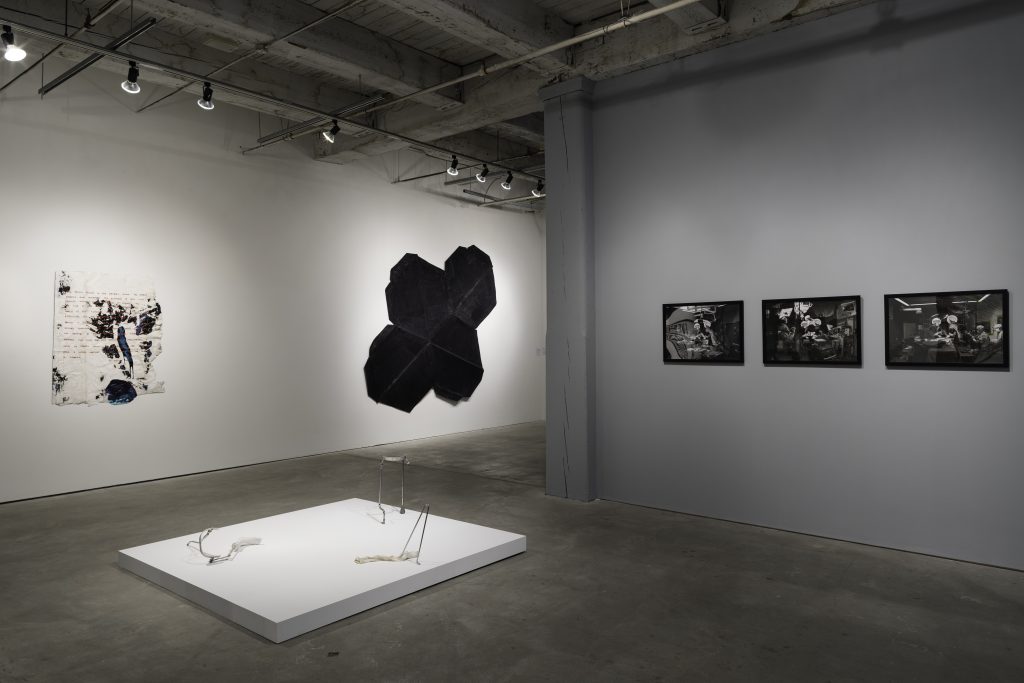
When I started thinking about hospitality and the body, a few years before I came to Bemis, it was through the history of transplantation. I began by asking, “What was the first Western artistic representation of a transplant?” I was shocked to learn that it was in 14th-century Italy. However, we owe the first version of the depicted story to 10th-century literature. In this story, a white man is sick. Saints Cosmas and Damian, who are twins, come to him in a dream and say, “Just today, an Ethiopian/Moor was buried in the cemetery. Go take his leg and we will put it in place of the bad one.” The very birth of the notion of transplantation is extractive and racialized. Artistic depictions of this story, now known as ‘the miracle of the black leg,’ thrived in Italy, Spain and beyond.
CN: It’s interesting that these mythologies formed before it was actually scientifically possible to conduct a successful transplant, or before they even understood how to do this or create any ethics behind it.
SF: Yes, and it’s also important to realize that their racialized extractivism lives on. In the 19th century, when medicine professionalized in the US, medical schools started needing a lot of corpses for dissections. How did they procure these bodies? As scholar Daina Ramey Berry has meticulously demonstrated in her book The Price for Their Pound of Flesh: The Value of the Enslaved, from Womb to Grave, in the Building of a Nation, grave robbing in African American cemeteries and the purchase of deceased slaves were the dominant means of procurement. Many US medical schools even had a gravedigger on staff.
This brings me back to the notion of the ‘guest’ in relation to hospitality – the root of the project. Transplantation ushered in varying conceptions of the body and healing by pointing to the slippery border between the living and nonliving, from flesh to ghosts and spirits. Hospitality allows me to think of these relationships together.
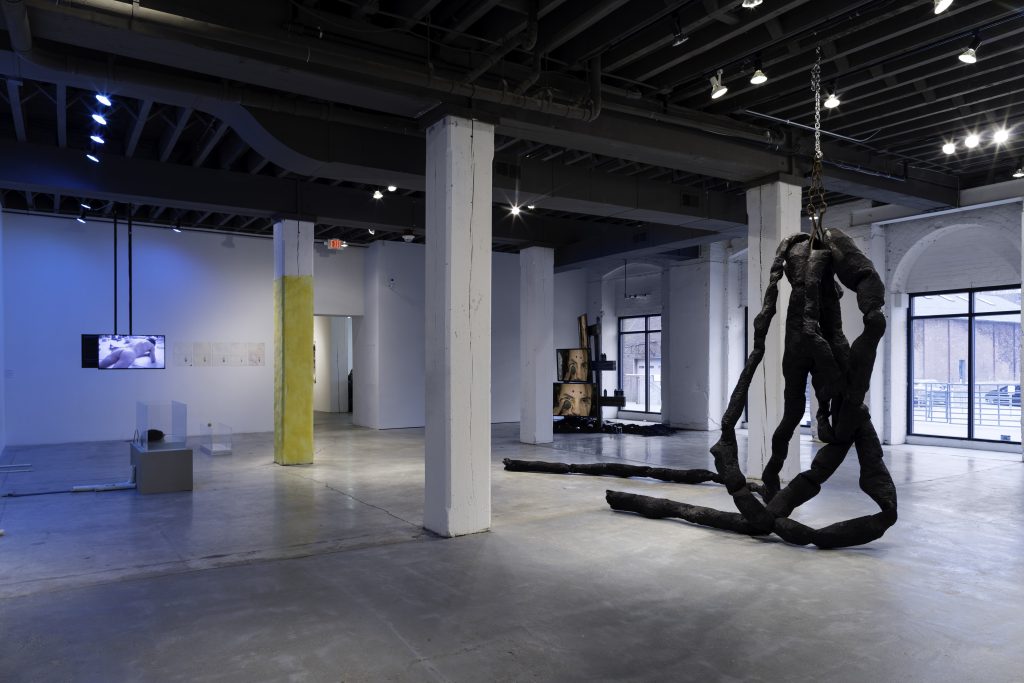
CN: It’s interesting thinking about the transplant in relation to hospitality, because the way you’ve described hospitality reflects a mode of caring that’s unconditional. You’re not getting something in return – there’s vulnerability. So, to me, transplantation is the ultimate act of hospitality. This also brings to mind surrogacy. These are all modes of altering the body, not necessarily in a ‘damaging’ way, but in a way that looks at the body as potential. Is this a concept that has a place in the exhibition?
SF: Absolutely, it has a central place. For me, potential is central to the relationship that is in hospitality – it’s the “unconditional” part. Pregnancy, or rather the placenta, offers another great model of (and for) hospitality. Earlier, I said that there are no preexisting host and guest – they co-create. In pregnancy, the placenta doesn’t exist before a body – whatever it may be – becomes a host. It’s co-produced by the child-to-be and the carrier, by their encounter. The placenta has a single, temporary purpose: to offer refuge, sustenance, and growth. Once that is no longer needed, it’s discarded. If we apply this model to curatorial work, then our research methodology should be like the placenta. This methodology is what sustains a curatorial project, and its purpose for the duration of that project.
CN: Right. Both exist for the purpose of supporting the other.
SF: Exactly.
CN: I love the title of the show: I don’t know you like that: The Bodywork of Hospitality. Where did it come from?
SF: One day, a woman was sitting across from me on the subway, talking on her phone. She said, “I don’t know you like that!” Her voice combined provocation, warmth, sassiness, and humor. I thought, this is it! This is the title of the show. I always want my titles to be accessible, evocative, and open-ended.
CN: It’s interesting that the title includes the word ‘work’ because it implies an acknowledgment of labor that is very important. But also the phrase, “I don’t know you like that,” is interesting because hospitality to me implies a welcoming and “I don’t know you like that” is a phrase that sets a boundary. So there’s this implication of a line that’s being crossed.
SF: Yes. I also think “I don’t know you like that” is about transforming relationships and shifting boundaries. “I don’t know you like that” implies that I know you in a different way. It’s about crossing boundaries. It’s a welcoming that acknowledges a threat.
CN: Like you’re suddenly exposed to this other part of a person.
SF: Exactly. And it’s also our relationship to our body. We’re always changing. We’re also always hosting and evicting our various former selves.
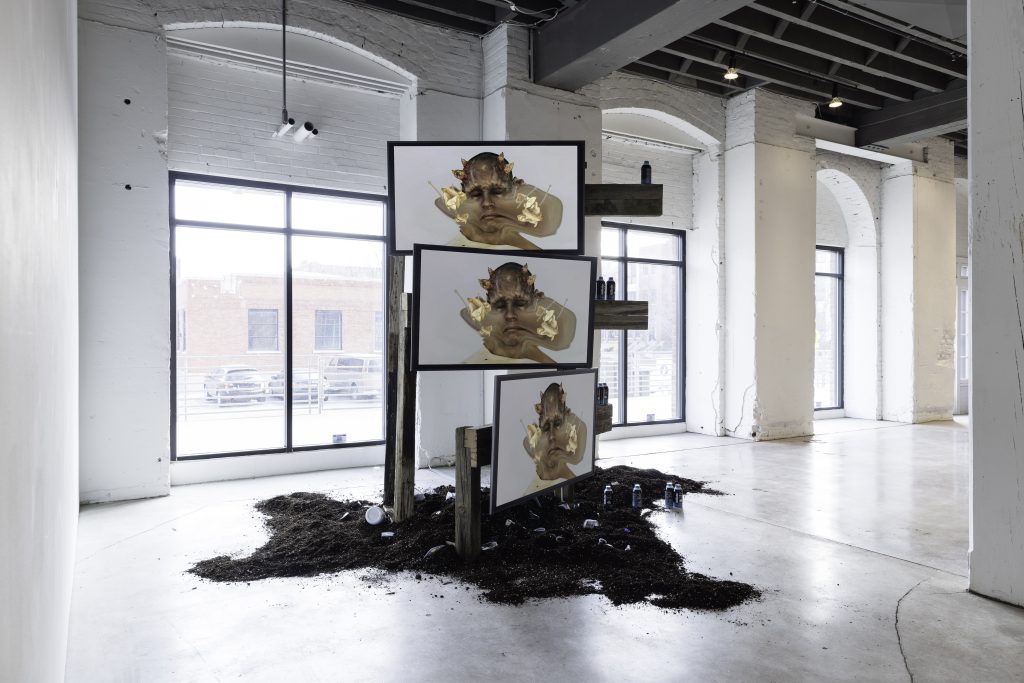
CN: I love asking curators to delve into one specific piece in the show – it doesn’t necessarily have to be your favorite piece.
SF: Okay, let’s talk about Adham Faramawy’s Skin Flick. At Bemis, it is presented as an installation: a video playing synchronously on three monitors on a wooden structure rising from soil and plastic trash. What I like particularly about this work is that it’s a video that shape-shifts with each manifestation. It exists as both a single-channel piece that can be projected and as an installation that takes different forms. I love that something as immaterial as a digital file can travel time and space and materialize in different ways, in relation to the site and to the way the artist’s own understanding of the work shifts. The piece is about a very porous body embroiled in relationships of desire and toxicity that expand both its internal functions and its external appearance. It’s about taking substances to enhance performance, but also about using beauty products to maintain youth. It is connected to the myth of Daphne as well, who transforms into a plant to avoid being caught in an undesired sexual relationship. While the work weaves together all these references that are central to Western culture, it also teases out a different reading, which undoes the superiority and mastery of the “human” subject – or rather, decenters a certain human subject.
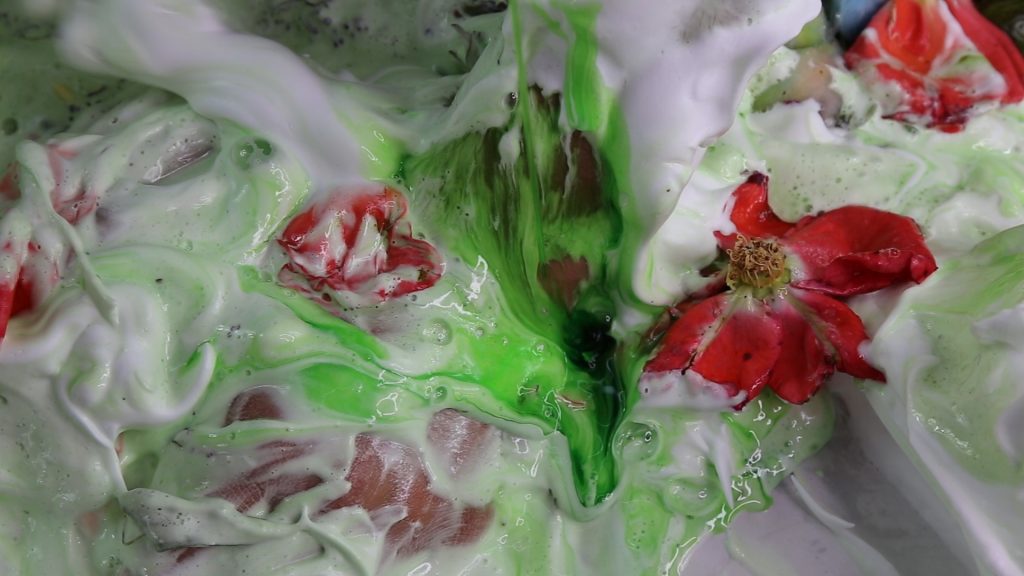
Jean-Charles de Quillacq created Armpit by covering one of the columns in the gallery with petroleum jelly onto which he carefully embedded armpit hair donated by an Omaha man he met on Tinder. Armpit is about the body’s pleasures and dangers– it’s about a leaky and porous body that could ruin its surroundings. It’s also about the fraught relationship between studio and the gallery – the studio’s dangers and the challenges it poses to exhibitionary forms. At Bemis, where columns are a distinctive feature of the galleries – the center’s bones – the piece whispers an institutional critique.
CN: Wow. Petroleum jelly is so malleable, it’s sort of in-between states. Lots of people don’t like it. The exhibition is so diverse in media and, in a way, that in and of itself is heavily related to the senses. However, the pieces don’t just engage the senses, they’re triggering different bodily responses. It seems that this was intentional so as to create visceral reactions from the viewers.
SF: Yes. By putting the works in conversation with each other in the physical space of the exhibition, I wanted to offer rich, multi-sensory experiences to open up ways of feeling and thinking. As a curator, I always want to bring in different materials, different media, different sensualities, and then create relationships that are unexpected.

Christina Nafziger is an art critic, editor, and writer based in Chicago (occupied land of Ohklahomo, Potawatomi, Ojibwe, and Odawa people). Earning an M.A. in Contemporary Art Theory from Goldsmiths University of London, her research focuses on the effect photo collections and archiving have on memory and identity and the potential capacity these collections have in altering and editing future histories. Working with a collaborative approach to her editorial work, her writing investigates the work of artists with research-based practices and how they engage with archives.
